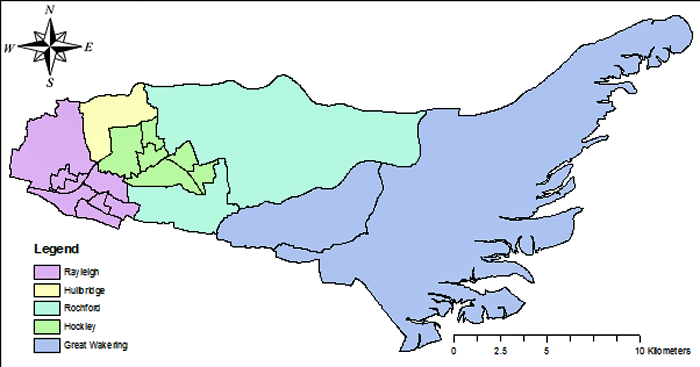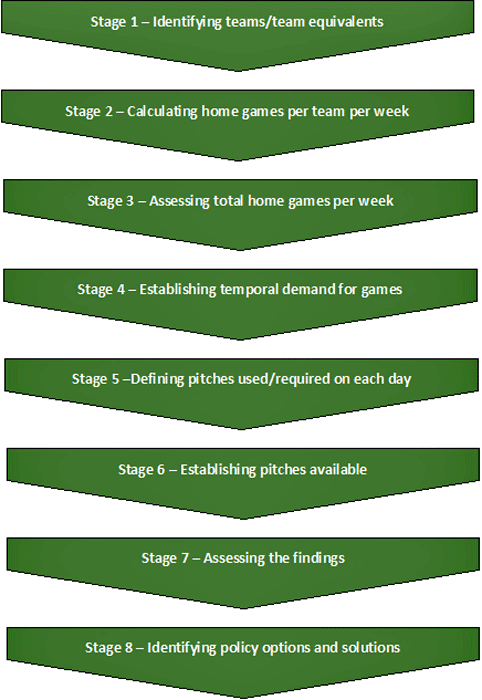Playing Pitch Strategy SPD
(1) Chapter 3 - Methodology
3.1 The Playing Pitch Methodology outlined in the Sport England guidance Towards a Level Playing Field: a Guide to the Production of Playing Pitch Strategies will be used as a guide to determine the current provision of playing pitches within the District. It will also aid decision-making, particularly with respect to increasing housing allocations, population growth and changing pitch demand.
3.2 The methodology provides a sound universal benchmark to which all local authorities can be measured against.
3.3 A successful methodology and Strategy relies upon the accuracy of the information used. Full and reliable data of the football, rugby, hockey and cricket clubs playing on pitches within the District was collected through liaising with different council departments, consulting governing bodies, examining league handbooks and distributing questionnaires to community clubs and schools.
3.4 An important aspect of the assessment is to determine the level of secured community use, which refers to the amount of access the community has to the use of a playing pitch.
(1) Defining a Team
3.5 Teams, as defined within Sport England guidance, are used to determine the level of demand for playing pitches. Teams for each sport were identified, along with ‘team equivalents’, for example junior teams converted into an adult equivalent, to provide a standard baseline.
Sports Included
3.6 This assessment has taken into consideration the wide variety of team games which may be played on a playing pitch, as defined above, such as football, cricket, rugby, hockley rounders, baseball and lacrosse. The predominant sports, however, which form the majority of team participation in Rochford District, are the focus of this study. These include association football (from hereon referred to as ‘football’), rugby union (from hereon referred to as ‘rugby’), cricket and hockey. Other pitch sports i.e. rounders and baseball which are not popular and have no sport club set up or playing within the District will not be included in the study this time.
Study Area and Sub-Areas
3.7 The whole of the Rochford District is the study area for this assessment. As required by Sport England, however, in assessing current playing pitch provision and demand, the study has endeavoured to identify local District teams which may, for a variety of reasons, play home games outside the District’s boundaries.
3.8 The District is divided and analysed according to five distinct sub-areas, as set out in Table 3.1 below, due to their differing geographical characteristics and population structures.
Table 3.1 – The clusters of wards in the Rochford District which make up the five sub-areas
| Sub-Areas | Wards Included |
|---|---|
| Rayleigh | Downhall & Rawreth, Sweyne Park, Grange, Wheatley, Rayleigh Central, Lodge, Whitehouse, Trinity |
| Hockley | Hockley North, Hockley West, Hockley Central, Hawkwell North, Hawkwell South, Hawkwell West |
| Rochford | Rochford, Ashingdon & Canewdon |
| Great Wakering | Barling & Sutton, Foulness & Great Wakering |
| Hullbridge | Hullbridge |
3.9 The geographical extent of each sub-area is shown in the figure below.
The Playing Pitch Model
3.10 The eight-stage model has been used to determine the level of supply and demand for playing pitches within Rochford District. The first six stages quantify the findings of the questionnaires and the last two stages aim to develop conclusions and appropriate policy options for managing future demand.
Our Approach
3.11 A comprehensive list of clubs for football, rugby, cricket and hockey clubs playing in the District was predominantly complied through the use of the Essex County Football Association’s league handbook, sports association websites such as the FA, league websites and information from relevant departments.
3.12 All primary and secondary schools within the District were included as part of the playing pitches review as current or potential providers of pitches for community use.
3.13 Questionnaires (which can be viewed in Appendix B and C) were sent out to club secretaries and schools based on the information gathered, to obtain relevant information such as home pitches to accurately complete the Playing Pitch Model and to determine the balance between supply and demand within the District. Further information was obtained, where necessary, using league websites, club websites and third party websites to determine the league in which teams are playing, and when they are playing their home games.
Response Rate
3.14 The table below summarises the response rate from the sports clubs and schools consulted as part of the Playing Pitch Strategy.
(2) Table 3.2 – Sample sizes and response rate by different sports club
| Respondent | Number of questionnaires sent | Number of questionnaires received | Response Rate |
|---|---|---|---|
| Football Club |
|
|
|
| Cricket Club |
|
|
|
| Rugby Club |
|
|
|
| Hockey Club |
|
|
|
| Schools/Colleges |
|
|
|


